In my experience, introducing math concepts to children can either be incredibly frustrating or inspiring.
Math is everywhere in our daily lives, and inviting children into learning in a natural and organic way is the best first step to life-long journey of understanding and appreciating mathematics. I feel math can be especially enriching when the concepts are integrated with real life experiences.
In my family, we have one child who has been particularly interested in math from a young age, but I wanted to respect his development and did not want to jump the gun on formal academics too soon. I wanted to incorporate numbers and math practices, but in a gentle and inviting way.
For young children interested in math, what can we offer for learning while still keeping it gentle and interactive?
In this blog post:
- Introducing math with a gentle invitation
- Math concepts for the early years and preschool
- Hands-on math activities for the early years and preschool
- Beloved preschool learning resources from Treehouse Schoolhouse
Introducing math with a gentle invitation
During the early years, such as preschool or kindergarten, my focus is to develop a love for literature, give lots of time for unstructured play, and develop the habit of attention. These are the elements I nurture during these years, not academics.
When my children show signs of readiness for formal learning, I invite them into our homeschool. All four of my children come together most days to study the Bible as a family, participate in Morning Time and nature study, and read together with picture books or during our read-alouds. I do not push academics until my children are ready. If it seems like they are not engaged with the subject matter, I do not push it. I believe that children will respond better to learning when they are ready.
When I introduce concepts like number recognition or counting, we do it playfully. Regardless of what my children grasp, it is a special time together when we are learning side-by-side.
I also introduce more formal learning in short bursts of time. For example, my kindergarten-aged son may spend 10-15 minutes writing numbers or playing a game, and that’s it. During the day, we may lightly touch on math topics we encounter. For example, we may measure ingredients together as I prepare breakfast, or count the rocks he collects when he plays outside. While our “formal” learning periods may be brief, we teach and explore math naturally as it presents itself in our daily activities.
For a peek into our homeschool day at this stage, watch the YouTube video below:
While academics are not my priority, when my children are ready to introduce concepts like the alphabet or numbers, I love to do it through hands-on play.
Math concepts for the early years and preschool

Children between ages 3 and 6 often start learning about math by learning the names of numbers 1-10 and then progressing to other ideas like counting and grouping.
Other concepts children can learn at this age include recognizing numbers, identifying more and less of a quantity, and understanding one-to-one correspondence, like matching sets or knowing the quantity of each group. They can also learn to identify shapes and perform simple addition.
As children explore numbers and math in various ways, it helps develop a strong, foundational number sense. As children learn, they begin to develop a framework to understand and organize numbers and number relationships, which can underscore their mathematical learning for years to come.
Much like the way we encounter literature, I believe math learning and practice at this age is just a way to expose children to new concepts and empower them to learn.
Hands-on math activities for the early years and preschool
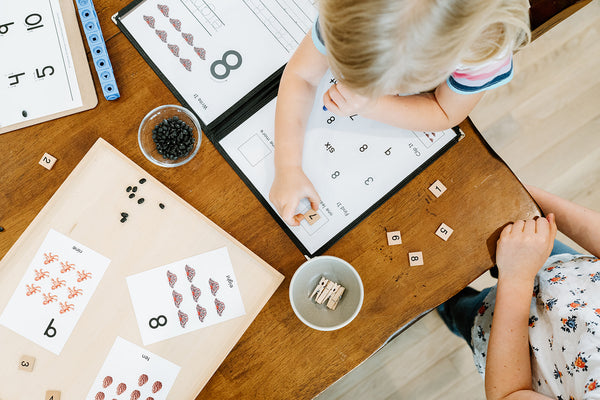
My favorite way to introduce math to my children is through tactile, hands-on learning. I think this format is ideal for children at this age who may not sit still or focus for long periods, and are still learning the motor skills of handwriting. Here are some of the ways I like to do this with my children.
Number recognition and counting
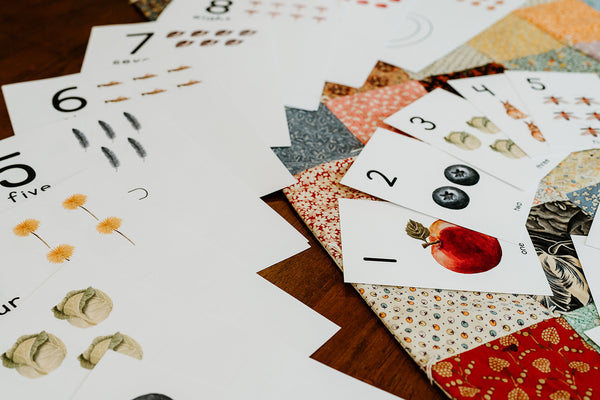
- Create visual numbers – Gather items from nature like sticks or leaves. Have your child call out a number and use the items to form the number. (Nature Inspired Learning)
- Number scavenger hunt – During a walk or a car drive, call out a number and ask your child to find it in their surroundings, like on a sign or a mailbox.
- String beads on pipe cleaners – Use pipe cleaners as “string” and count the beads as your child threads the pipe cleaner through each bead.
- Dice rolling – Roll dice and have your child name the number the die settles on. You could also match each dice with the corresponding numeral or number card.
- Stacking blocks – Stack blocks or other objects and count as you go.
- Counting with number cards – Displaying number cards, use your hand to cover the numeral on the card. Have your child count the number of watercolor illustrations printed on the card and tell you what number it is. Show your child the corresponding number.
- Number card scavenger hunt – Hide number cards around the room. Write out numbers 1-10 on a large paper. As your child finds each number, match the number card to the number on the paper.
- Build a city – Use Lego to build a city that stacks as high as the corresponding number. (Cinta & Co.)
- Fill a cup – Roll the dice and fill cups with the corresponding number of loose objects. (Frugal Fun for Boys and Girls)
- Balloon bounce – Throw a balloon in the air and count the number of times you can keep it from hitting the ground.
- Counting flower petals – Gather flowers outdoors and count the number of petals on each flower.
- Counting pinecones – Write numbers 1-10 on the ground with sidewalk chalk. Gather the corresponding number of pinecones or another item from nature and place it by each number. (Fun-A-Day)
- Number toy hunt – Write numbers 1-10 on different pieces of paper. Draw a corresponding number of empty circles on each paper. Gather toys that correspond to the number and place them on the empty circles. (Toddler Approved)
- How many is 100? – Create a grid on the floor with 10 squares. Fill each square with groups of 10 objects like coins or stickers to create a visual of what the number 100 looks like. (Busy Toddler)
- Number jump – Spread the cards all over the floor. Call out a number and have your child stand by the number card and jump the corresponding number of times.
- Number clip – Use clothespins to clip the correct amount of clips onto number cards.
Number sequence and sorting
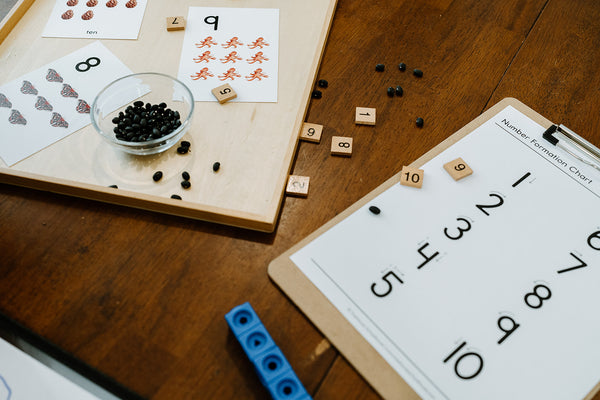
- Number rocks – Collect rocks from outside and label them with numbers 1-10. Have your child place them in the correct order. (Fun-A-Day)
- Number cards in numerical order – Scatter number cards around a table or floor and ask your child to move them into numerical order.
- Coin sorting – Use masking tape or painter’s tape to tape a grid on the floor. Use the grid to sort coins by type within each grid. (Busy Toddler)
- Pom pom sorting – Fill a sink or bin with water. Drip pom poms of different colors into the water. Using a large spoon, have your child remove the pom poms one color at a time.
- Happy and sad face sorting – Gather pictures of faces from your photos or magazines. Sort them into piles of happy faces and sad faces. (Having Fun at Home)
- Apple sorting activity – Gather red and green apples and two baskets. Have your child put red apples in one basket and green apples in another. (The Resourceful Mama)
- Nature sorting activity – Gather items from nature like rocks, acorns, or pinecones. Sort the items by their similar traits, like color or size. (Nature Inspired Learning)
- Color sorting – Set out different colors of construction paper. Find objects around the house that are the various colors and set them on the coordinating piece of paper. You could also do this with stickers, pipe cleaners, beads, and more. (What We Do All Day)
- Egg carton sorting – Label each space in an egg carton with numbers 1-12. Place the corresponding number of pom poms in each space. (What We Do All Day)
- Card sorting – Using a deck of cards, have your child sort the deck into stacks of color, suit, or number. (What We Do All Day)
- Sticky sort – Display contact paper on a table or a wall with the sticky side up. Cut pieces of construction paper into small squares. Sort the squares of construction paper by color by sticking each square to contact paper. (Busy Toddler)
- One less one more – Using a dry-erase marker and the Wonder of Nature Number Sheets, practice number sequence by inviting your child to write the numbers that come before and after in the blank boxes. Use the number line as a reference.
Shapes
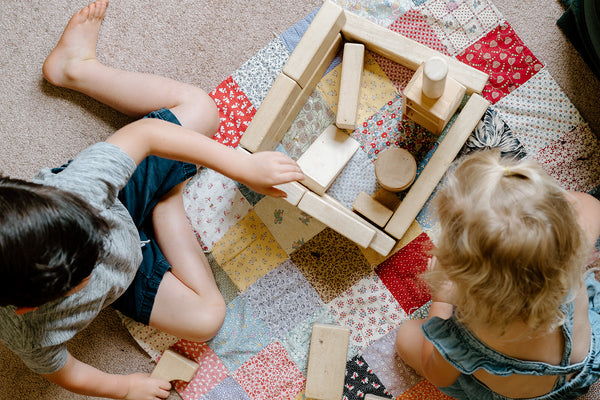
- Shape art activity – Draw overlapping shapes on a large piece of paper. Color or paint each shape. Identify and discuss the various shapes in the large shapes and smaller, overlapping shapes. (Busy Toddler)
- Create shapes with objects – Using objects from nature like sticks, flowers, or rocks, line the items up to create shapes like circles or squares. (Nature Inspired Learning)
- Everyday shapes – Point and discuss shapes in everyday life like the tires on the card, the shape of letters in the mail, and signs on the road. (Hands On As We Grow)
- Window shapes matching – Cut out shapes from foam. On a window, use a dry-erase marker to outline corresponding shapes. Match the foam shape to the corresponding shape on the window. (Powerful Mothering)
- Shape hopscotch – Use sidewalk chalk to draw various shapes on the ground outside. Call out the name of a shape and have your child throw rocks to the corresponding shape or jump to it. (Creative Family Fun)
- Play-Doh shape building – Get out the Play-Doh and stamp or cut out various shapes. (The Preschool Toolbox)
- Pancake shapes – Make pancakes into various shapes, or use a fork and knife to cut the pancake into different shapes. (Discovery Play with Littles)
- I Spy – Play a game of I Spy and look for different shapes in your surroundings.
- Shape sorter – Use a shape sorter to sort shapes of different sizes and colors.
- Giant shape match activity – Using kraft paper, outline different shapes like blocks or other household objects. Invite your child to match the block to the corresponding shape on the paper. (Busy Toddler)
Related: Overview: Wonder of Nature Collection
Adding, subtracting, and measuring
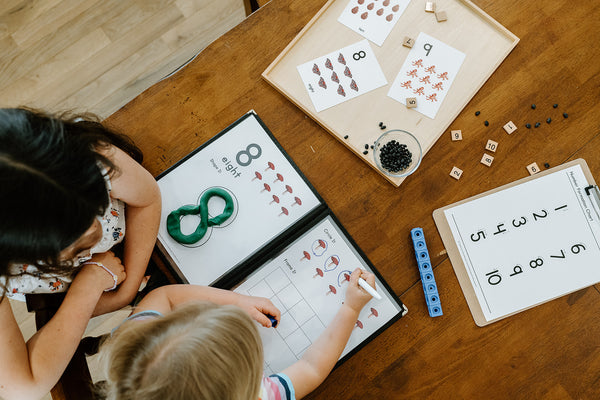
- Number cards for simple addition and subtraction – Use number cards to display a simple math problem and have your child locate the card that shows the sum or difference.
- Hands-on addition activity – Use pom poms and egg cartons to demonstrate adding in real life. Invite your child to select numbers and use the pom poms and egg cartons to demonstrate adding the numbers together. Count the sum of all of the pom poms. (Busy Toddler)
- Blocks addition activity – Write out addition problems on paper and demonstrate them by stacking blocks. After stacking the blocks, count out the total number of blocks to demonstrate the sum.
- Addition clouds – Cut out shapes of clouds and write addition problems (“1+2” or “2+5”) on each cloud. Glue the clouds on a piece of paper. Under each cloud, have your child fingerprint raindrops to show the sum. (Preschool Play and Learn)
- Subtraction snacks – Set out several food items for your child, like blueberries or cereal. Count the total number and ask your child to subtract or take away a certain number of items by eating them.
- Number cards subtraction – Demonstrate subtraction with number cards by using your hands to cover several illustrations. Have your child count the sum of the remaining illustrations.
- Play-Doh subtraction smash – Form balls of Play-Doh and have your child smash the ones you subtract or take away. (Mama. Papa. Bubba.)
- Slide beads on pipe cleaners – String a sum of beads on a pipe cleaner. Write a subtraction formula on a piece of paper. “Take away” the beads on the pipe cleaner and count how many beads are remaining. (We are Teachers)
- One less one more – Using a dry-erase marker and Wonder of Nature Number Sheets, practice number sequence by inviting your child to write the numbers that come before and after in the blank boxes. Use the number line as a reference.
- Measuring with string – Measure various household objects with string. Cut each string to mark the length and compare the length of different objects. (Friends Art Lab)
- Outdoor size hunt – Talk about “big” or “small” with your child. Identify “big” or “small” objects and compare them with things in nature. For example, you can say “Find something bigger than your hand” or “Find something smaller than your shoe.” (Empowered Parents)
- How many hands tall? – Trace your child’s hand and cut it out. (You may want to use a photocopier to speed this up.) Have your child lay on the ground and measure how many hands tall they are. You can also use your hands to measure other household objects like the kitchen counter or kitchen table. (Empowered Parents)
- Baking measurements – Have your child help measure out ingredients in the kitchen and talk about it as you go!
For frequently asked questions about homeschooling kindergarten, check out the YouTube video below:
Are you looking for more learning resources for your homeschool? Consider these best-selling products from Treehouse Schoolhouse that offer a gentle invitation to learning.
Treehouse Story School: Preschool

Treehouse Story School: Preschool is 32-weeks of gentle, literature-based curriculum designed for ages 2.5-5 years. This preschool curriculum that invites children to learn through the themes in stories they love. Each week will focus on a picture book, inviting children into connection and learning through music and movement, play-based narration, alphabet and number play, motor skills, practical life development, crafts, and baking together.
It would be a great fit for your toddler or preschooler if you are looking to incorporate multi-sensory, play-based learning while introducing them to timeless stories.
From toddler through upper preschool, this curriculum can be used year after year as you dive deeper into beloved, classic stories your family will cherish. Preview a free week here.
Daily Rhythm Bundle

Children are highly visual–they can feel particularly out of control when they don’t know what to expect of their day. That’s why we recommend using a visual schedule to support your children from the time they are very young.
Rather than trying to stick to a rigid schedule, this set helps you create a general rhythm for your days. The daily rhythm worksheet is laminated and dry erase and the cards can be moved around offering you flexibility and adaptability.
Morning Time Bundle

This interactive, reusable set focuses on weather, seasons, moon phase, temperature, weather-appropriate clothing, date and time, and reading a calendar. With this daily bundle, your child will practice the skills of handwriting, tracing, copywork, and telling time. I recommend you print these materials and place them inside of a Morning Time Menu or dry-erase sleeve. Using dry-erase markers, your child can fill this bundle out over and over again.
We also offer a version of the Morning Time Bundle for those in our community who live in the Southern Hemisphere.
How do you introduce mathematics in your homeschool? Let me know in the comments below.

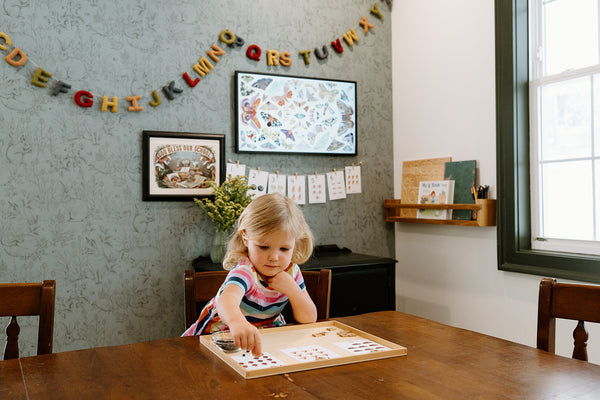
![Winter Solstice Activity for Kids [Free Worksheet PDF]](https://storage.googleapis.com/treehouse-schoolhouse-media-dev/fe547f4b-gn4a7877-scaled.jpg)

